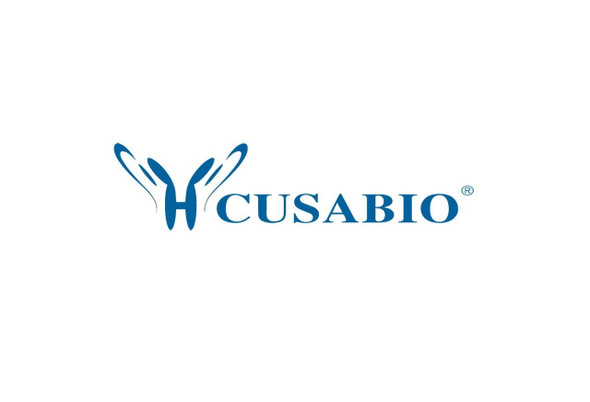Cusabio Active Proteins
Recombinant Human Tumor necrosis factor protein (TNF), partial (Active) | CSB-AP002141HU
- SKU:
- CSB-AP002141HU
- Availability:
- 5 to 10 Working Days
Description
Recombinant Human Tumor necrosis factor protein (TNF) ,partial (Active) | CSB-AP002141HU | Cusabio
Protein Description: Partial
Alternative Name (s) : Cachectin, Tumor necrosis factor ligand superfamily member 2, TNF-a, , NTF
Gene Names: TNF,TNFA,TNFSF2
Research Areas: Cancer
Species: Homo sapiens (Human)
Source: E.Coli
Tag Info: N-terminal 6xHis-tagged
Expression Region: 77-233aa
Sequence Info: MHHHHHH+VRS SSRTPSDKPV AHVVANPQAE GQLQWLNRRA NALLANGVEL RDNQLVVPSE GLYLIYSQVL FKGQGCPSTH VLLTHTISRI AVSYQTKVNL LSAIKSPCQR ETPEGAEAKP WYEPIYLGGV FQLEKGDRLS AEINRPDYLD FAESGQVYFG IIAL
Biological Activity: Fully biologically active when compared to standard. The ED50 as determined by a cytotoxicity assay using murine L929 cells is less than 0.05 ng/ml, corresponding to a specific activity of > 2.0 × 107 IU/mg in the presence of actinomycin D.
MW: 18.3 kDa
Purity: >97% as determined by SDS-PAGE and HPLC.
Endotoxin: Less than 1.0 EU/µg as determined by LAL method.
Relevance: Cytokine that binds to TNFRSF1A/TNFR1 and TNFRSF1B/TNFBR. It is mainly secreted by macrophages and can induce cell death of certain tumor cell lines. It is potent pyrogen causing fever by direct action or by stimulation of interleukin-1 secretion and is implicated in the induction of cachexia, Under certain conditions it can stimulate cell proliferation and induce cell differentiation. Impairs regulatory T-cells (Treg) function in individuals with rheumatoid arthritis via FOXP3 dephosphorylation. Upregulates the expression of protein phosphatase 1 (PP1) , which dephosphorylates the key 'Ser-418' residue of FOXP3, thereby inactivating FOXP3 and rendering Treg cells functionally defective (PubMed:23396208) . Key mediator of cell death in the anticancer action of BCG-stimulated neutrophils in combination with DIABLO/SMAC mimetic in the RT4v6 bladder cancer cell line (PubMed:22517918) . {ECO:0000269|PubMed:16829952, ECO:0000269|PubMed:22517918, ECO:0000269|PubMed:23396208}.; The TNF intracellular domain (ICD) form induces IL12 production in dendritic cells. {ECO:0000269|PubMed:16829952}.
PubMed ID: 3555974; 6392892; 3883195; 2995927; 3856324; 3932069; 8499947; 10202016; 14656967; 15489334; 8631363; 8597870; 10205166; 2009860; 1402651; 9034191; 10369255; 16829952; 16829951; 22517918; 23396208; 2922050; 1964681; 2551905; 9488135; 9442056; 12746914; 12915457
Notes: Repeated freezing and thawing is not recommended. Store working aliquots at 4℃ for up to one week.
Function: Cytokine that binds to TNFRSF1A/TNFR1 and TNFRSF1B/TNFBR. It is mainly secreted by macrophages and can induce cell death of certain tumor cell lines. It is potent pyrogen causing fever by direct action or by stimulation of interleukin-1 secretion and is implicated in the induction of cachexia, Under certain conditions it can stimulate cell proliferation and induce cell differentiation. Impairs regulatory T-cells (Treg) function in individuals with rheumatoid arthritis via FOXP3 dephosphorylation. Upregulates the expression of protein phosphatase 1 (PP1) , which dephosphorylates the key 'Ser-418' residue of FOXP3, thereby inactivating FOXP3 and rendering Treg cells functionally defective
Involvement in disease: Psoriatic arthritis (PSORAS)
Subcellular Location: Cell membrane, Single-pass type II membrane protein, SUBCELLULAR LOCATION: Tumor necrosis factor, membrane form: Membrane, Single-pass type II membrane protein, SUBCELLULAR LOCATION: Tumor necrosis factor, soluble form: Secreted, SUBCELLULAR LOCATION: C-domain 1: Secreted, SUBCELLULAR LOCATION: C-domain 2: Secreted
Protein Families: Tumor necrosis factor family
Tissue Specificity:
Paythway: MAPKsignalingpathway
Form: Lyophilized powder
Buffer: Lyophilized from a 0.2 m filtered PBS, pH 7.0
Reconstitution: We recommend that this vial be briefly centrifuged prior to opening to bring the contents to the bottom. Please reconstitute protein in deionized sterile water to a concentration of 0.1-1.0 mg/mL.We recommend to add 5-50% of glycerol (final concentration) and aliquot for long-term storage at -20℃/-80℃. Our default final concentration of glycerol is 50%. Customers could use it as reference.
Uniprot ID: P01375
Uniprot Entry Name: TNFA_HUMAN
HGNC Database Link: HGNC
UniGene Database Link: UniGene
KEGG Database Link: KEGG
STRING Database Link: STRING
OMIM Database Link: OMIM









